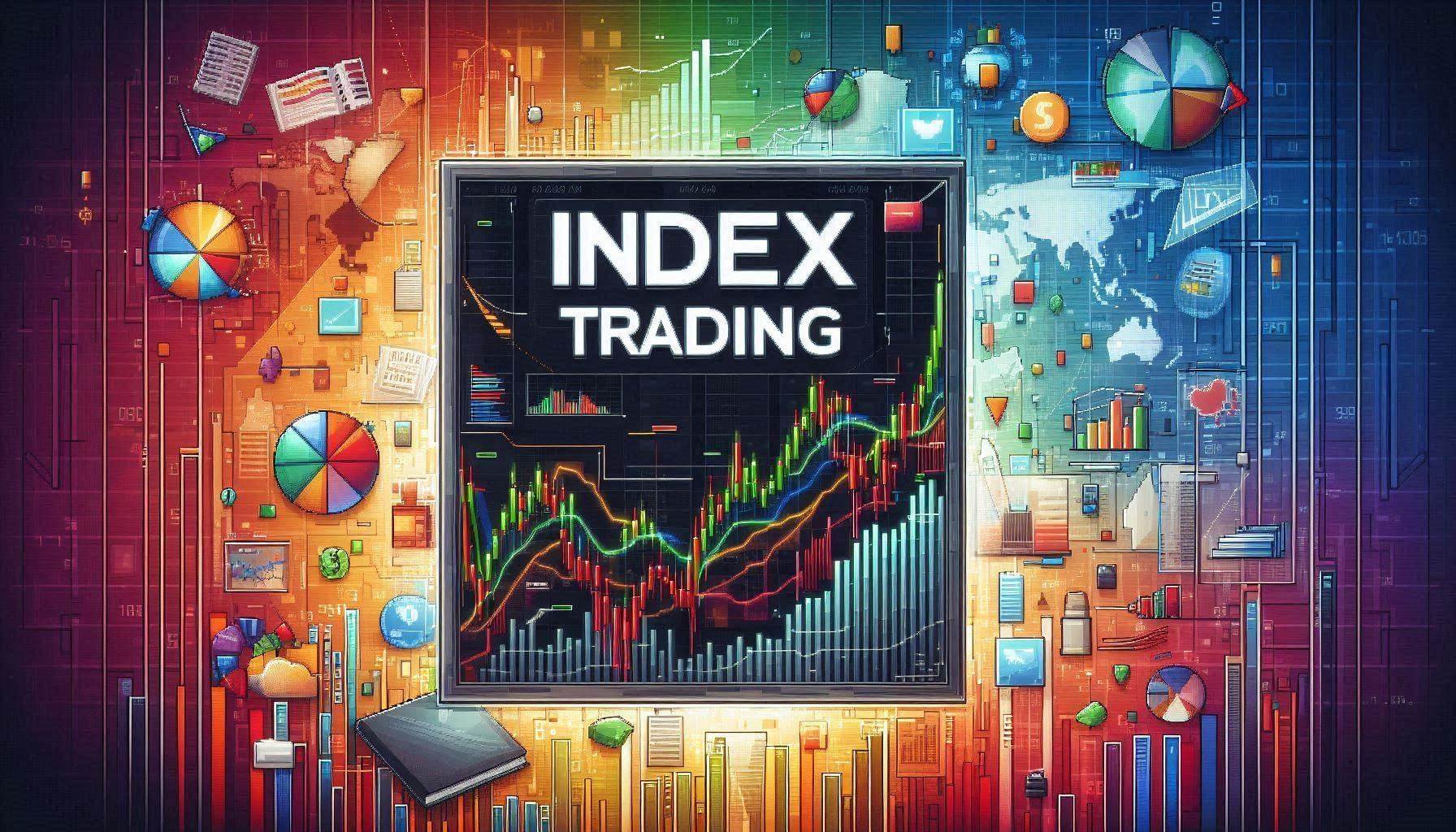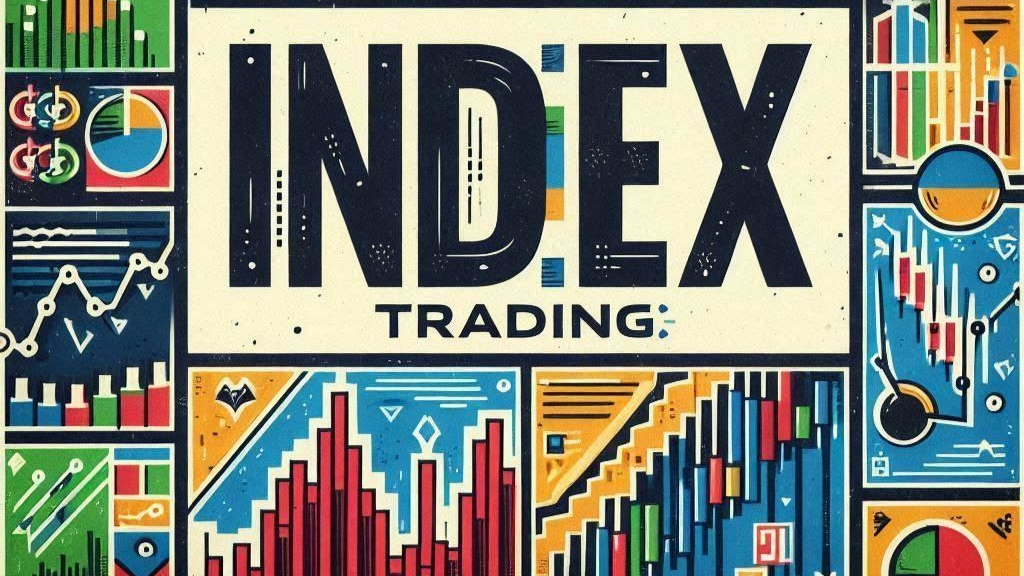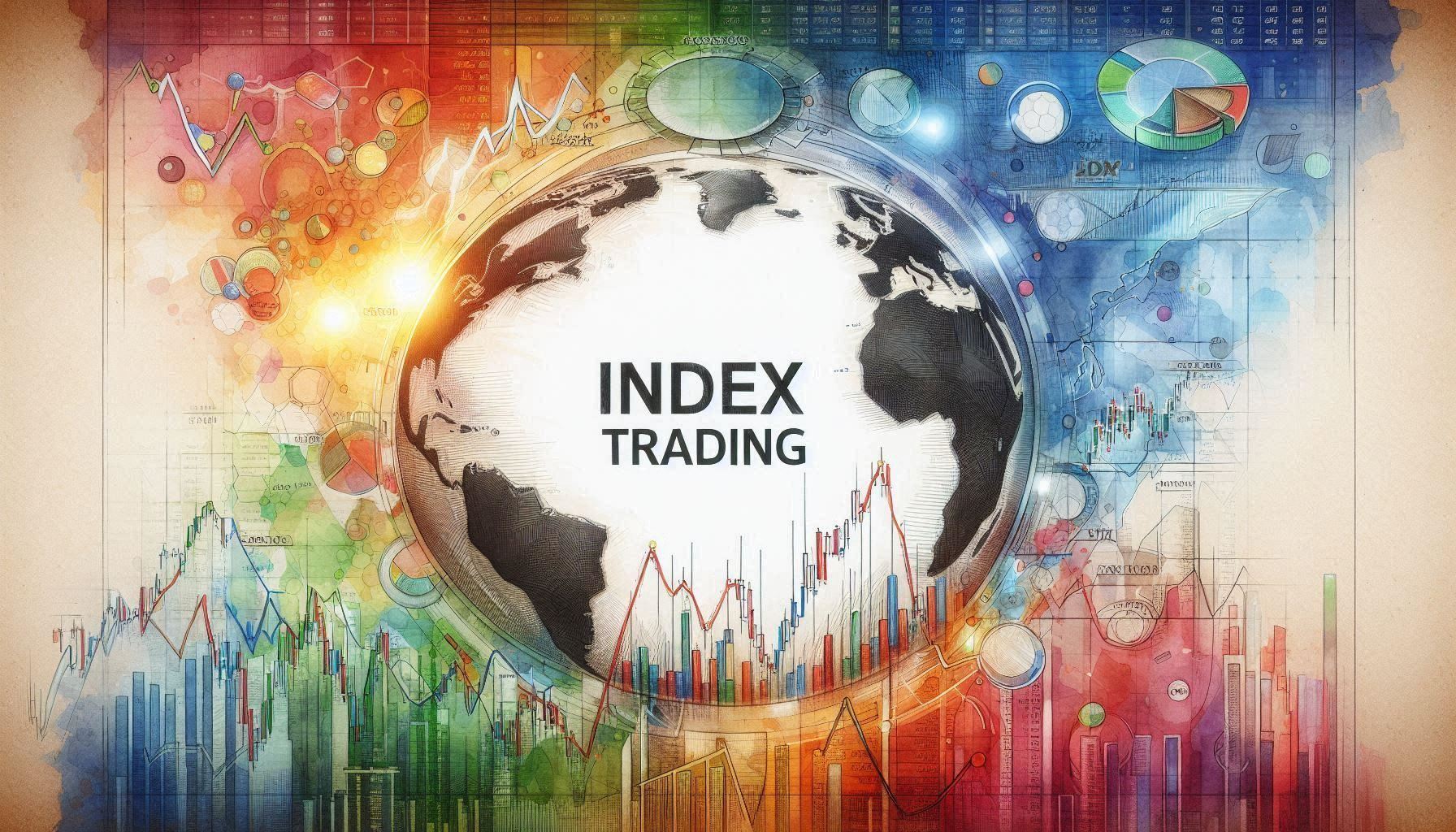Index trading involves buying and selling a group of stocks collectively known as an index. They represent a specific segment of the market or the market as a whole. Unlike individual stock trading, index trading allows traders to gain exposure to a wide range of companies and sectors through a single transaction, making it a popular choice for diversifying and managing risk. If you are unfamiliar with index terms in the financial market, take a quick look into the Beginner’s Guide to indices article.
Whether you’re a trader or new to the financial markets, index trading provides a strategic approach to your trading. Indices leverage the collective performance of many companies, potentially leading to more stable returns in a volatile market environment. In this article we are going to learn about why and how to trade indices.
Table of Contents
What is Index Trading?
Index trading involves buying and selling a group of stocks that make up a market index. A market index tracks the performance of a specific basket of stocks that represent a particular market or sector of the economy.
Therefore, traders can speculate on the price of an index rising or falling, which then determines whether they will be buying (going long) or selling (going short).
It is important to understand that an index only represents the performance of a group of stocks. However, trading indices does not mean you are buying any actual underlying stock to take ownership of. Instead, you are trading the average performance or price movements of the group of stocks. When the price of shares for the companies within an index goes up, the value of the index increases. If the price instead falls, the value of the index will drop.
What Moves the Price of Index?
The movement of index prices is primarily dependent on external forces. The price will decrease in times of uncertainty that bring weakness to the relevant country’s economy. Some factors that can impact the price of an index include:
Global News
Events such as natural disasters, pandemics, political instability, conflicts, and wars can all have a major impact on indices. It could be confined to only one country (like an earthquake in Japan) or it could have a global impact (like a war between two or more countries).
Economic Indicators
Economic events and meetings such as central bank rate decisions, non-farm payrolls, trade agreements, and employment indicators can have a major impact on indices. Some could be specific to only one index; for example, UK employment numbers would primarily impact the FTSE 100 (Britain´s main stock index). Other events, such as the meeting of the US central bank, could impact indices all around the world because the USD is the dominant global currency.
Index reshuffle
When a company’s stock is added or removed from a stock index, it can impact the price of the index. Generally, a reshuffling of the index is beneficial for traders, as it ensures only relevant companies remain part of the index.
One example is the once-famous photography company Kodak. It was a part of both the Dow Jones 30 and the S&P 500 for a long time but was eventually dropped from both indices as it continued to struggle, and its market capitalization shrank.
Company News
Earnings results, mergers and acquisitions, changes in leadership, and other major company-specific news can all affect the index of which the company is a part. The higher the weight of the company, the more impact the news will have on the index. For example, Apple announcing much better than anticipated earnings numbers would have a positive impact on both the S&P 500 and the NASDAQ 100.
How Does Index Trading Work?
When you trade indices online, there are two main types: index cash CFDs (Contract for Difference) and index futures CFDs. The main difference between the cash market and futures market is that the cash market does not have an expiry date. The futures market, however, has an expiry date, normally known as a rollover. A futures contract is effectively an agreement between the buyer and the seller on the price that must be paid by the buyer at a given future date.
There are two main types of indices you can trade:
- Index cash CFDs: Featuring tighter spreads based on spot pricing, cash indices are more suitable for short-term traders. Cash CFD traders tend to avoid holding positions overnight to avoid paying overnight trade charges and will reopen trades the next day.
- Index futures CFDs: With a contract based on a price for future delivery, Index Futures CFD trades are preferred by traders interested in medium- to long-term trading. This is because this type of trade does not incur overnight funding or swap charges.
An example of index CFD trading
Let’s say you’re interested in trading CFD cash based on the S&P 500 index, which is currently trading at 3,800 points.
- You believe the index will rise, so you decide to buy 5 CFDs at the current price.
- The total position size is (5 * 3,800) points = 19,000 points.
- Your broker requires a 5% margin for index CFDs.
- The margin requirement for your trade is (0.05 * 19,000) points = 950 points.
- This means you need to have at least 950 points worth of capital in your account to open this trade.
Trade Moves in Your Favor:
The index moves up to 3,850 points, and you decide to close your position.
The difference in points is (3,850 – 3,800) = 50 points.
Your profit is (5 * 50) points = 250 points.
Trade Moves Against You:
If the index had fallen to 3,750 points and you closed your position, the difference would be (3,750 – 3,800) = -50 points.
Your loss would be (5 * -50) points = -250 points.
What Is the Best Time to Trade Indices?
There are certain time periods throughout the trading week where market volumes and prices tend to be more active as the market factors in all the news and events since the previous close. For experienced traders, the interval between 9:30 and 10:30 a.m. ET is the best hours of the day, as it offers the biggest moves in the shortest amount of time. Also, Economic reports and news releases can have a significant impact on market indices. Trading around these times can be profitable but also riskier.
You should also consider that different indices are traded at separate times, depending on the individual exchange. If you are new to trading, you may want to consider avoiding trading during these hours, when high volatility may cause rapid price fluctuations. However, this can also be the ideal time to learn by observing and analyzing market behavior.
Also, If you’re trading global indices, consider the hours when multiple markets are open at the same time, as this can increase liquidity. The optimum time to trade is simply when the markets open in different time zones. Because index markets do not operate continually like the currency market, you must choose the optimal time to open a trade.
Why Trade Indices?
Indices give you the opportunity to trade the direction of the stock market as a whole.
For example, if you expect that the US is heading towards a recession and that the domestic stock market will decline, it would be inefficient, inconvenient, and expensive to enter short positions on many individual stocks. Instead, you could place a single CFD short on the Nasdaq 100 and profit from potential downturn in the index.
Indices also provide diversification. You may feel comfortable trading only one asset class (like forex), but if you find yourself in a situation where your strategy is not working anymore. For example, due to a lack of volatility, it could be an opportunity to test your strategy on other products.
Indices are highly liquid, which means they are suitable both for short-term and long-term trading.
How to Trade Indices?
Indices are accessible to anyone, and it is possible to get started with a little money. Here is a quick, step-by-step guide on how to trade indices:
- Educate yourself: Understand what indices are and how they work. Indices track the performance of a group of stocks, representing a specific market or sector.
- Choose the right index: Select an index that aligns with your investment goals. Consider factors like geographical location, market sector, and performance history. Popular instruments include the Dow Jones 30, S&P 500, DAX 40, and FTSE 100.
- Select a trading platform: Choose a reputable trading platform or broker that offers the indices you’re interested in. Ensure they provide the tools and resources you need.
- Set up a trading account: Open a trading account with your chosen platform. You’ll need to provide some personal information and possibly deposit funds.
- Develop a strategy: Decide on a trading strategy. Will you trade long-term or short-term? What’s your risk tolerance? Consider using technical analysis, fundamental analysis, or a combination of both.
- Use risk management tools: Employ risk management tools like stop-loss orders to protect your investment from significant losses.
- Place your trade: Once you’re ready, place your trade. You can trade indices through various financial instruments like index funds, exchange-traded funds (ETFs), or derivatives like options and futures.
- Monitor your trade: Once you place your trade, you need to monitor it to ensure that it is performing as expected. You can close your trade at any time, either to take profits or to limit losses.
Generally, if you are new to indices trading, it is important to educate yourself on how the market works and the risks involved. Boost your trading skills with our 4-week incubator program.
Advantages of Index Trading
There are several reasons why Index trading is popular among beginner traders and experienced investors for many years. These include:
- Market exposure: Trading indices allows you to gain exposure to a diversified basket of stocks or assets, providing a snapshot of the overall market or a specific sector.
- Flexibility: Indices trading offers flexibility in terms of trading strategies. The ability to go long or short means you can take advantage of stock indices’ falling or rising prices.
- Less capital needed: Minimal capital is required to start index trading, and the costs are lower than trading the actual futures contract.
- Diversification: Index trading allows traders to spread their risk across many different stocks, reducing the impact of any single company’s performance overall.
- Simplicity: Trading indices is straightforward, making it accessible even for novice investors. It eliminates the need to analyze and select individual stocks.
- Accessibility: Index trading provides access to markets that may be difficult or too costly to access directly, such as international markets or specific sectors.
- Cost-Effectiveness: Since index funds are not managed by managers, they often come with lower management fees compared to actively managed funds.
- Leverage: Many index trading products, such as futures and CFDs, offer leverage, allowing you to control a larger position with a smaller amount of capital. This amplifies both potential profits and losses.
- Liquidity: Indices are typically highly liquid, allowing for easy entry and exit from the market. This allows for the efficient execution of trades with minimal slippage.
- Hedging: Trading indices can be used for hedging purposes to offset potential losses in other parts of your portfolio. For example, if you have a stock-heavy portfolio, you can use index futures to hedge against overall market downturns.
Disadvantages of Trading Indices
Trading indices, while popular for their simplicity and diversification, do come with certain disadvantages:
- Volatility: Indices trading can be highly volatile, subject to sudden and significant price fluctuations. This volatility can lead to substantial gains or losses, depending on market conditions.
- Tracking Error: This is the discrepancy between the performance of the index fund and the underlying index. It can occur due to timing differences, transaction costs, or issues with replicating the index.
- Dividend Yield: Indices typically have a lower dividend yield compared to some individual stocks, which may be a disadvantage for income-seeking investors.
- Leverage risks: While leverage can amplify profits, it also increases the potential for substantial losses. Inexperienced traders may find it challenging to manage the risks associated with leverage.
- Limited control: Traders have no control over the individual components of the index. If certain sectors or stocks within the index perform poorly, traders must bear the brunt of these downturns. Even if an individual stock within an index performs exceptionally well, its impact on the overall index may be minimal, or vice versa.
- Over-Diversification: While diversification reduces risk, it can also dilute returns. In a rising market, holding a broad index may result in lower returns compared to selectively investing in high-performing stocks.
- Lack of fundamental analysis: Index trading often relies more on technical analysis and market trends than detailed fundamental analysis of individual stocks. This can limit traders’ ability to identify undervalued or overvalued stocks based on their financial performance or other company-specific factors.
- Market Risk: Indices are exposed to overall market risks. Economic downturns or market crashes can lead to significant losses, as indices will mirror the broader market’s decline.
Final Words
In conclusion, index trading offers traders a strategic approach to gain exposure to a broad market segment or the entire market. It provides a diversified trading avenue with typically lower fees and more flexibility compared to actively managed funds. While it mirrors the performance of the selected index, it is crucial for traders to be aware of the inherent risks, including market volatility and potential tracking errors. Nonetheless, for those seeking a long-term investment strategy that aligns with market trends, index trading stands out as an efficient and cost-effective option.
FAQs
- Can a beginner trade indices?
Yes, a beginner can trade indices, and it’s often recommended as a starting point for those new to trading. Index trading can be less complex than trading individual stocks because it doesn’t require extensive knowledge of individual company performances. - Are trading indices profitable?
Trading indices can be profitable, but like any investment, it comes with risks and there are no guarantees. The profitability of index trading depends on several factors, including market conditions, the trader’s skill level, strategy, and risk management practices. - How much money do you need to trade indices?
The amount of money you need to trade indices can vary widely depending on several factors, including the platform you use, the type of trading you engage in, and the specific indices you’re interested in. - Which indices are easy to trade?
Indices that are considered easy to trade are typically those that are widely recognized, have a large number of participants, and are available through various trading platforms. Some indices that are often recommended for beginners due to their liquidity and ease of access are: S&P 500, Dow Jones Industrial Average (DJIA) and Nasdaq 100. - Are indices easier than forex?
Whether indices are easier to trade than forex can depend on the individual trader’s experience, preferences, and goals. However, Beginners often find indices trading more approachable as it allows them to get exposure to the stock market without having to pick individual stocks. Forex trading can be more challenging due to its complexity and the need for precise timing.














